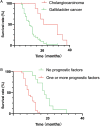Hepatopancreatoduodenectomy for advanced biliary malignancies
- PMID: 35916551
- PMCID: PMC9943980
- DOI: 10.1097/CM9.0000000000002067
Hepatopancreatoduodenectomy for advanced biliary malignancies
Abstract
Background: Hepatopancreatoduodenectomy (HPD) has been considered the only curative treatment for metastatic cholangiocarcinoma and some locally advanced gallbladder cancers (GBCs). However, HPD has not yet been included in treatment guidelines as a standard surgical procedure in consideration of its morbidity and mortality rates. The aim of this study was to evaluate the safety and effectiveness of HPD in treating biliary malignancies.
Methods: The medical records of 57 patients with advanced biliary cancer undergoing HPD from January 2009 to December 2019 were retrospectively retrieved. A case-control analysis was conducted at our department. Patients with advanced GBC who underwent HPD (HPD-GBC group) were compared with a control group (None-HPD-GBC group). Baseline characteristics, preoperative treatments, tumor pathologic features, operative results, and prognosis were assessed.
Results: Thirteen patients with cholangiocarcinoma and 44 patients with GBC underwent HPD at our department. Significant postoperative complications (grade III or greater) and postoperative pancreatic fistula were observed in 24 (42.1%) and 15 (26.3%) patients, respectively. One postoperative death occurred in the present study. Overall survival (OS) was longer in patients with advanced cholangiocarcinoma than in those with GBC (median survival time [MST], 31 months vs . 11 months; P < 0.001). In the subgroup analysis of patients with advanced GBC, multivariate analysis demonstrated that T4 stage tumors ( P = 0.012), N2 tumors ( P = 0.001), and positive margin status ( P = 0.004) were independently associated with poorer OS. Patients with either one or more prognostic factors exhibited a shorter MST than patients without those prognostic factors ( P < 0.001).
Conclusion: HPD could be performed with a relatively low mortality rate and an acceptable morbidity rate in an experienced high- volume center. For patients with advanced GBC without an N2 or T4 tumor, HPD can be a preferable treatment option.
Copyright © 2022 The Chinese Medical Association, produced by Wolters Kluwer, Inc. under the CC-BY-NC-ND license.
Conflict of interest statement
None.
Figures



Similar articles
-
A modified surgical approach of hepatopancreatoduodenectomy for advanced gallbladder cancer: Report of two cases and literature review.J Huazhong Univ Sci Technolog Med Sci. 2017 Dec;37(6):855-860. doi: 10.1007/s11596-017-1817-6. Epub 2017 Dec 21. J Huazhong Univ Sci Technolog Med Sci. 2017. PMID: 29270743 Review.
-
Hepatopancreatoduodenectomy: its suitability for bile duct cancer versus gallbladder cancer.J Hepatobiliary Pancreat Surg. 2007;14(2):142-8. doi: 10.1007/s00534-006-1108-2. Epub 2007 Mar 27. J Hepatobiliary Pancreat Surg. 2007. PMID: 17384904
-
Review of hepatopancreatoduodenectomy for biliary cancer: an extended radical approach of Japanese origin.J Hepatobiliary Pancreat Sci. 2014 Aug;21(8):550-5. doi: 10.1002/jhbp.80. Epub 2014 Jan 27. J Hepatobiliary Pancreat Sci. 2014. PMID: 24464987 Review.
-
Is extended hemihepatectomy plus pancreaticoduodenectomy justified for advanced bile duct cancer and gallbladder cancer?Surgery. 2013 Jun;153(6):794-800. doi: 10.1016/j.surg.2012.11.024. Epub 2013 Feb 13. Surgery. 2013. PMID: 23415082
-
Hepatopancreatoduodenectomy for cholangiocarcinoma: a single-center review of 85 consecutive patients.Ann Surg. 2012 Aug;256(2):297-305. doi: 10.1097/SLA.0b013e31826029ca. Ann Surg. 2012. PMID: 22750757
Cited by
-
Risk factors and survival prediction model establishment for prognosis in patients with radical resection of gallbladder cancer.World J Gastrointest Surg. 2024 Oct 27;16(10):3239-3252. doi: 10.4240/wjgs.v16.i10.3239. World J Gastrointest Surg. 2024. PMID: 39575289 Free PMC article.
-
Fatty Acid Binding Protein 1 is an Independent Prognostic Biomarker for Gallbladder Cancer with Direct Hepatic Invasion.Int J Med Sci. 2024 Mar 25;21(5):862-873. doi: 10.7150/ijms.93413. eCollection 2024. Int J Med Sci. 2024. PMID: 38617005 Free PMC article.
-
TEAD4 promoted proliferation and metastasis of gallbladder cancer by regulation of TMPRSS4.Clin Exp Metastasis. 2025 Apr 11;42(3):22. doi: 10.1007/s10585-025-10339-0. Clin Exp Metastasis. 2025. PMID: 40214821
-
ELF3 promotes gemcitabine resistance through PKMYT1/CDK1 signaling pathway in gallbladder cancer.Cell Oncol (Dordr). 2023 Aug;46(4):1085-1095. doi: 10.1007/s13402-023-00799-5. Epub 2023 Mar 29. Cell Oncol (Dordr). 2023. PMID: 36988891
References
-
- Takasaki K, Kobayashi S, Mutoh H. Our experiences (5 cases) of extended right lobectomy combined with pancreato-duodenectomy for the carcinoma of the gall bladder. Tan to Sui 1980; 1:923–932.
-
- Mizuno T, Ebata T, Yokoyama Y, Igami T, Yamaguchi J, Onoe S, et al. . Major hepatectomy with or without pancreatoduodenectomy for advanced gallbladder cancer. Br J Surg 2019; 106:626–635. doi: 10.1002/bjs.11088. - PubMed
-
- Hemming AW, Magliocca JF, Fujita S, Kayler LK, Hochwald S, Zendejas I, et al. . Combined resection of the liver and pancreas for malignancy. J Am Coll Surg 2010; 210:808–816. doi: 10.1016/j. jamcollsurg.2009.12.007. - PubMed
-
- Lim CS, Jang JY, Lee SE, Kang MJ, Kim SW. Reappraisal of hepatopancreatoduodenectomy as a treatment modality for bile duct and gallbladder cancer. J Gastrointest Surg 2012; 16:1012–1018. doi: 10.1007/s11605-012-1826-5. - PubMed
-
- Dai WC, Chok KS, Cheung TT, Chan AC, Chan SC, Lo CM. Hepatopancreatoduodenectomy for advanced hepatobiliary malignancies: a single-center experience. Hepatobiliary Pancreat Dis Int 2017; 16:382–386. doi: 10.1016/S1499-3872(17)60039-0. - PubMed
MeSH terms
LinkOut - more resources
Full Text Sources
Medical

